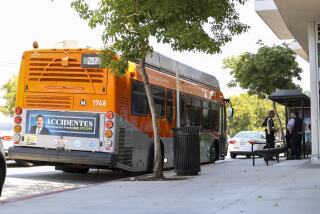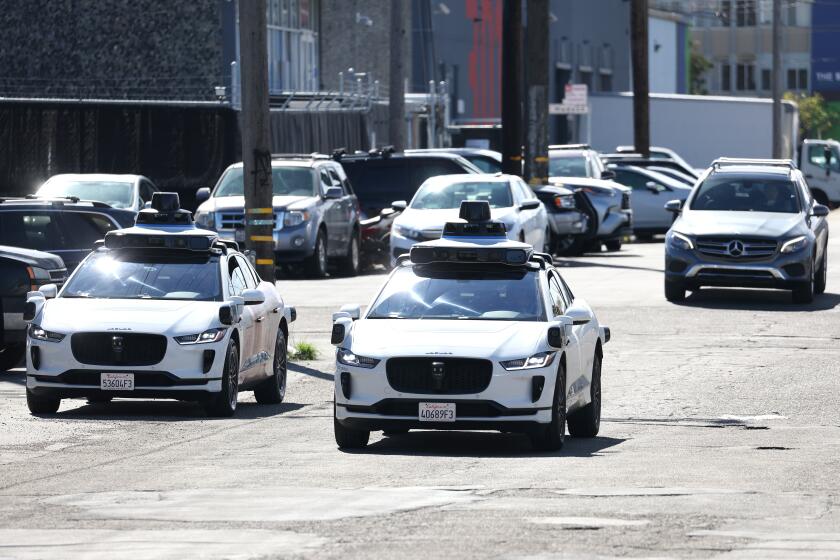Covina: New Kind of Whistle Stop
- Share via
A few years ago, residents of villages near EuroDisney east of Paris complained that the theme park’s miniature train whistle made their dogs bark and their geese honk.
In Covina, train horns have made the residents growl.
But the San Gabriel Valley city is hoping it has found a way to coexist with a revival of rail travel in the Los Angeles region. Covina is seeking to become one of the nation’s first federally approved “quiet zones,” where trains would be prohibited from sounding their horns except in emergencies.
That, officials hope, will also silence residents who complain that horns from 24 commuter trains passing through town every weekday--from just after 5 a.m. until 9 p.m.--wake them up, drown out conversations and TV programs, fray their nerves and generally shatter the peace.
“We have two constituencies--those who want more trains and those who want no trains,” said Stephenie Frederick, administrative analyst for the city. “The quiet zone is a way of satisfying both constituencies.”
Trains now sound their 96-decibel horns before every crossing, making about as much noise as a jackhammer, city officials say. At a minimum, 1,536 train horns are sounded every week in Covina, Frederick said.
“We realized even before we started operating that the horn was going to be very intrusive, and we were getting letters from people miles away from the right of way,” said Richard Stanger, executive director of the Southern California Regional Rail Authority, which operates 106 Metrolink trains along 416 miles of track in six counties.
The agency moved the horn lower on its locomotives and built a box around it in order to direct the noise to the front instead of the sides, but complaints persist. A Covina resident in 1995 unfurled a banner on her house, declaring simply, “Metrolink sucks.”
Metrolink officials have joined Covina in petitioning the Federal Railroad Administration for the quiet zone designation. Stanger said he expects federal approval.
Similar zones could be established in other neighborhoods built along tracks that were once lightly used but are becoming busier with the region’s emerging network of rail lines.
The problem is acute in Covina, city officials say, because homes are closer to the tracks. Furthermore, because of the proximity of crossings, train horns can be heard in some parts of town continuously for a minute or longer.
“No one who purchased homes in these areas ever anticipated that the rail line would get the heavy commuter rail usage that it has now,” Frederick said.
The horn-blowing varies with the engineer’s personality.
“Some of them just tap on the horn just enough to conform with all requirements and alert people in the crossing, and others really put their heart and soul into it, and then my phone rings,” Frederick said.
Even with the quiet designation, locomotive engineers would retain the right to blow the horn when they spot unsafe conditions, such as a pedestrian on the tracks. In lieu of the audible warning, Covina and its safety consultant, J.L. Patterson & Associates, have proposed additional safeguards to prevent accidents at crossings. These include stepping up police patrols at crossings and installing eight-inch-high curbs to prevent motorists from pulling around lowered gates.
The idea for quiet zones grew out of efforts to find an alternative to whistle bans enacted in Florida communities without additional safeguards at crossings. The bans led to a threefold increase in accidents, authorities reported.
“We think it’s very important that railroads and communities live together in harmony,” said Grady Cothen, deputy associate administrator for safety standards at the Federal Railroad Administration. But communities must make safety improvements at crossings to compensate for the loss of audible warnings, Cothen said.
A motorist was killed by a train earlier this year in Covina’s first train fatality since Metrolink began service there in 1992.
Some residents welcome the quiet zone, but say that life is still difficult next to the tracks. “You grow accustomed to it,” Kim Moody, a mother of three, said of the horns. As she was talking, a train passed by and sounded a short tap. She is bothered more by the noise and rattling from freight trains passing at night. Sharon Cook, whose house backs up against the tracks, noted that the noise from one recent train was so loud that residents ran out of their houses. “They thought it was an earthquake.”
*
Richard Simon can be reached at richard.simon@latimes.com
More to Read
Sign up for Essential California
The most important California stories and recommendations in your inbox every morning.
You may occasionally receive promotional content from the Los Angeles Times.














